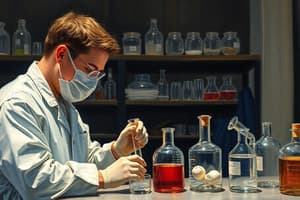Podcast
Questions and Answers
What is the primary function of a beaker in a laboratory setting?
What is the primary function of a beaker in a laboratory setting?
- To hold liquids and mix substances (correct)
- To filter solid from liquid solutions
- To heat substances rapidly
- To measure the exact volume of liquids
Which apparatus is specifically designed to measure the exact volume of a liquid?
Which apparatus is specifically designed to measure the exact volume of a liquid?
- Graduated cylinder (correct)
- Erlenmeyer flask
- Petri dish
- Test tube
In chemical reactions, what does it mean to balance a chemical equation?
In chemical reactions, what does it mean to balance a chemical equation?
- Matching the heat energy produced by the reactants
- Keeping the reaction duration constant
- Making sure the number of atoms for each element is the same on both sides (correct)
- Ensuring the physical state of reactants and products are the same
What should be done when borrowing laboratory materials from the lab?
What should be done when borrowing laboratory materials from the lab?
What is a key safety practice to follow in the laboratory?
What is a key safety practice to follow in the laboratory?
Flashcards are hidden until you start studying
Study Notes
Basic Safety Practices
- Always wear safety goggles, gloves, and lab coats to protect against chemical splashes.
- Know the location of safety equipment like eyewash stations, safety showers, and fire extinguishers.
- Avoid eating or drinking in the lab to prevent contamination and ingestion of hazardous materials.
Protocols in Borrowing Laboratory Materials
- Obtain permission before using or borrowing equipment from the lab.
- Return borrowed materials in the same condition they were received; report any damages.
- Keep track of borrowed items and their return deadlines to avoid fines or replacement costs.
Basic Apparatus & Equipment Functions
- Beakers: Used for mixing, stirring, and heating liquids; allows for easy measurement of liquid volume.
- Flasks:
- Erlenmeyer Flask: Ideal for mixing and swirling liquids without risk of spillage due to its narrow neck.
- Volumetric Flask: Designed for precise measurement and containing a specific volume of liquid.
- Pipettes: Instruments used for transferring precise volumes of liquids; available in various types, including graduated and volumetric pipettes.
- Graduated Cylinders: Used for measuring liquid volumes accurately; taller and narrower than beakers.
- Burettes: Essential for titrations; allows precise dispensing of liquid with a stopcock for control.
- Test Tubes: Used for holding, mixing, or heating small quantities of substances; benefit from being easily heated and cooled.
Chemical Formula Writing
- Understand basic principles of writing chemical formulas, including the use of symbols for elements and subscripts for the number of atoms.
- Follow the conventions of oxidation states when applicable to denote the charge of ions in compounds.
Naming and Balancing Chemical Reactions
- Use the IUPAC naming system for compounds, including prefixes for molecular compounds and suffixes indicating oxidation states.
- Balancing involves ensuring the number of atoms for each element is the same on both sides of the reaction equation, following the law of conservation of mass.
- Practice balancing through trial and error or using algebraic methods for more complex reactions.
Studying That Suits You
Use AI to generate personalized quizzes and flashcards to suit your learning preferences.




